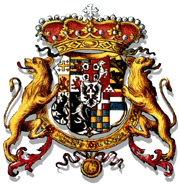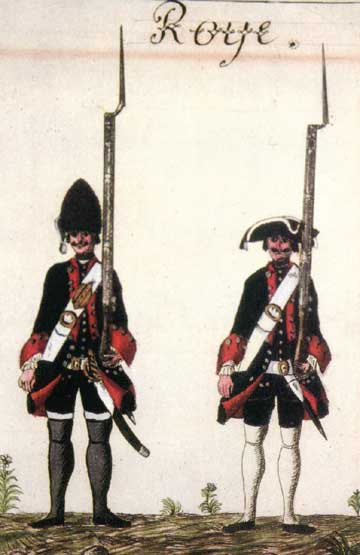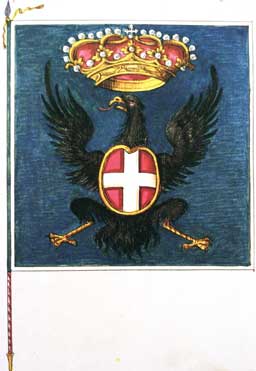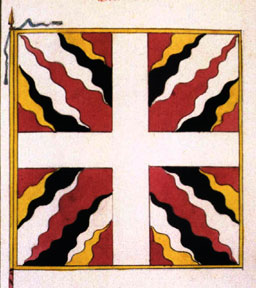
Regiment suisse de Diesbach
ROQUIN
1733 - 1798
Le Roi Charles Emmanuel III signa, le 14 novembre 1733,
une convention avec le Colonel Albert Louis Roquin de Suerdon to raise
a swiss infantry regiment called Roquin. The men are assembled from the
country around the City of Berne. In 1734 the Regiment is ready in Turin
with a force of two battalions.
Service during the Polish Succession War
Roquin, after garrison duties, in september 1735 is present
on the west side of lake of Garda supporting the french action on the East
side. At the end of the action, the 8 november, Roquin takes winter quarters
in the country around Cremona and Brescia.
In 1737 the regiment changes its commander; since 17 may
1737 the new Colonel is Jean Rodolfe de Diesbach. The regiment changes
its old name in Diesbach. This unit is not disbanded but the capitulation
between the King and Jean Diebach is renewed for other twelve years. At
the end of 1742 a 3rd battalion is raised. Each battallion has 4 companies.
Service during the Austrian Succession War
In 1742 Diesbach is campaigning in north-east Italy in
the Po plains. During the spring of that year we find Diesbach in the City
of Piacenza. In September the regiment is divided; the 1st and the 2nd
battalions stay in garrison in Po cities, such as Modena, while the 3rd
battalion marches on the Alps; from the camp of Novalesa in Susa Valley
the Regiment pass the Mount Cenise gap an it takes action in Savoy during
the counter-offensive against the invading Spanish army. In jenuary 1743
3rd Diesbach returns again in Piedmont. The 1st and 2nd battalions fight
at Camposanto (8 february 1742). The whole regiment is reunify and marches
to the west front. Behind the trenches in Varaita Valley Diesbach is waiting
for the main french-spanish invasion of Piedmont. During the combats of
Chateau Dauphin (8 october 1743) Diesbach is entrenched around the village
of Chateau. The follow year its principal task is the control of the Alpine
frontiers. The 10 april Colonel Agustine Roquin is the new commander of
the regiment renamed Roquin. The Prince Conti's action reaches again the
Varaita Valley. This regiment is one of the units that fight at the redoubt
of Mount Cavallo during the battle of Pierre Longue (17 july 1744). During
the hard combat, the 1st and 2nd battalion make a fierce defence inside
the redoubt but at the end they are drived out during the last successful
french attack losing 372 men. The brave Colonel Roquin, while defending
with his officier's spontoon the palissade, is shot down hit at the head.
Yet the 22 july the regiment has a new colonel, Charles Antoine Roy, and
a new name, Roy. After the defeat the whole piedmontese army is concentrated
in south west Piedmont in order to break the siege of the Place Fort of
Cuneo. So the three battalions of the regiment are present at Madonna dell'Olmo
(30 september 1744). Roy is situated on the right wing, first line. In
1745 the great Maillebois' offensive gives no match to the Piedmontese
hope to stop it. After the battle of Bassignana (27 september 1745) Roy
leaves its 3rd battalion to defend the new bult powerful Citadel of Alessandria.
It helds the block of the fortess for six month (11 november 1745 &endash;
11 march 1746). The other two battalions of Roy are in the order of battle
of Leutrum's army in the well planned counter offensive that clear the
piedmontese landscape. Then the regiment marches in the south-west in the
mediterranean theatre. But in 1747 the regiment is urgently recalled on
the Alpine front. Again the 3rd battalion takes a day of glory. The battalion
helds the redoubt of Gran Serin, defending it against the extremely dangerous
french assault of the Marquise de Villemur's right column. The trench were
defended by two battalion of Kalbermatten and the 3rd Roy against 14 enemy
battalions. The defence is successful and the day is saved.
In 1751 the capitulation is extended for other twelve
year. In 1760 the Regiment becomes Regiment Tscharner. In 1763 the previous
capitulation is confiermed.
Commanders of Regiment Fusiliers under Charles
Emmanuel III
| Albert Louis Roquin de Suerdon |
14 - 11- 1733 |
| Jean Rodolphe de Diesbach |
17 - 5- 1737 |
| Agustine Roquin |
10 - 4- 1744 |
| Charles Antoine Roy |
22 - 7- 1744 |
| Hemanuel Tscharner |
14- 4 - 1760 |
Uniformes

1730-1750: Dark blue coat with white laces, red
lining, cuffs, collar, dark bluewaistcoat with white laces, breeches. White
gaiters for fusilier, black for grenadiers. Eight tinned buttons on each
side of the coat, four ranks of two, four with lances on the cuffs. Horizontal
pockets. Tricorne with dark blue cockade on the left brim and white hem
for fusiliers, bearskin cap for grenadiers.

1750-1773 (only principal differences from the
previous issue):Dark blue coat, red lapels, lining and collar. Seven tinned
buttons on lapels, in ranks of two and one on the top. Tricorne with white
hem and black and white pompon. Bearskin cap with black tail, white hem
and black and white pompon.
Colours
Colonel's Colour:

Blue with black eagle in the centre decorated with the
Savoy's cross and overhanged by royal crown.
Regimental Colour:

Diesbach - White cross with
black, red and yellow flames.

Roy - White cross over blue,
yellow, black, red flames. Coat of armes of the City of Berne in the first
quarter.

Jean Cerino Badone
|